DMI – Graduate Course in Computer Science
Copyleft
![]() 2016-2017 Giuseppe Scollo
2016-2017 Giuseppe Scollo
this tutorial deals with:
problem: HW/SW partitioning the implementation of a dataflow system
here is a very simple example:
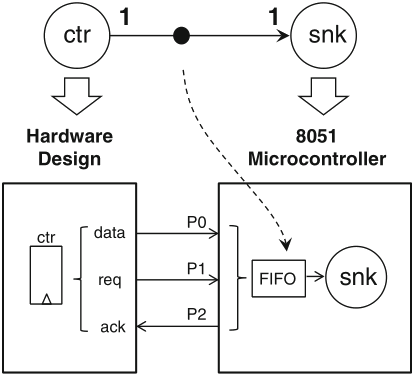
Schaumont, Figure 3.17 - Hybrid hardware/software implementation of a dataflow graph
dp send_token( out dout : ns(8);
out req : ns(1);
in ack : ns(1)) {
reg ctr : ns(8);
reg rack : ns(1);
reg rreq : ns(1);
always {
rack = ack;
rreq = rack ? 0 : 1;
ctr = (rack & rreq) ? ctr + 1 : ctr;
dout = ctr;
req = rreq;
}
sfg transfer {
$display($cycle, " token ", ctr);
}
sfg idle {}
}
fsm ctl_send_token(send_token) {
initial s0;
@s0 if (rreq & rack) then (transfer) -> s0;
else (idle) -> s0;
}
ipblock my8051 {
iptype "i8051system";
ipparm "exec=df.ihx";
ipparm "verbose=1";
ipparm "period=1"; }
ipblock my8051_data(in data : ns(8)) {
iptype "i8051systemsink";
ipparm "core=my8051";
ipparm "port=P0"; }
ipblock my8051_req(in data : ns(8)) {
iptype "i8051systemsink";
ipparm "core=my8051";
ipparm "port=P1"; }
ipblock my8051_ack(out data : ns(8)) {
iptype "i8051systemsource";
ipparm "core=my8051";
ipparm "port=P2"; }
dp sys {
sig data, req, ack : ns(8);
use my8051;
use my8051_data(data);
use my8051_req (req);
use my8051_ack (ack);
use send_token (data, req, ack);
}
system S { sys; }
#include <8051.h>
#include "fifo.c"
void collect(fifo_t *F) {
if (P1) { // if hardware has data
put_fifo(F, P0); // then accept it
P2 = 1; // indicate data was taken
while (P1 == 1); // wait until hardware ack
P2 = 0; // and reset
}
}
unsigned acc;
void snk(fifo_t *F) {
if (fifo_size(F) >= 1)
acc += get_fifo(F);
}
void main() {
fifo_t F1;
init_fifo(&F1);
put_fifo(&F1, 0); // initial token
acc = 0;
while (1) {
collect(&F1);
snk(&F1);
}
}
Schaumont, Listing 3.5 - GEZEL hardware description of data flow example of Fig. 3.17
hardware mapping of datapath expressions: same basic rules as with always blocks, however:
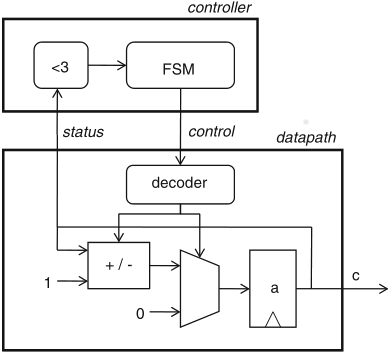
Schaumont, Figure 5.8 - Implementation of the up-down counter FSMD
function specification: computation of the median in a list of five numbers
problem: design a stream-processing filter that produces a new output upon each new input
for a fast algorithm, with no list sorting:
dp median(in a1, a2, a3, a4, a5 : ns(32); out q1 : ns(32)) {
sig z1, z2, z3, z4, z5, z6, z7, z8, z9, z10 : ns(3);
sig s1, s2, s3, s4, s5 : ns(1);
always {
z1 = (a1 < a2);
z2 = (a1 < a3);
z3 = (a1 < a4);
z4 = (a1 < a5);
z5 = (a2 < a3);
z6 = (a2 < a4);
z7 = (a2 < a5);
z8 = (a3 < a4);
z9 = (a3 < a5);
z10 = (a4 < a5);
s1 =
(( z1 + z2 +
z3 + z4) == 2);
s2 =
(((1-z1) + z5 +
z6 + z7) == 2);
s3 =
(((1-z2) + (1-z5) +
z8 + z9) == 2);
s4 =
(((1-z3) + (1-z6) + (1-z8) + z10) == 2);
q1 =
s1 ? a1 : s2 ? a2 : s3 ? a3 : s4 ? a4 : a5;
}
}
Schaumont, Listing 5.19 - GEZEL Datapath of a median calculation of five numbers
the algorithm presented by this datapath also works when some elements are equal
the presented algorithm requires 192 I/O lines and 10 comparators
to this end the hardware stores the four data preceding the last one from the input stream and at every iteration with a new input element reuses the stored results of six comparisons from the previous three iterations
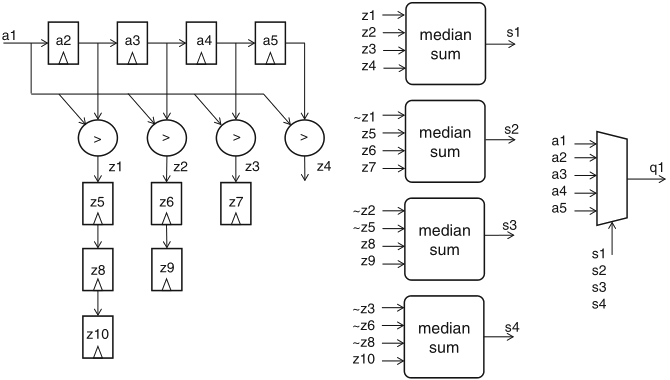
Schaumont, Figure 5.9 - Median-calculation datapath for a stream of values
dp median(in a1 : ns(32); out q1 : ns(32)) {
reg a2, a3, a4, a5 : ns(32);
sig z1, z2, z3, z4;
reg z5, z6, z7, z8, z9, z10 : ns(3);
sig s1, s2, s3, s4, s5 : ns(1);
always {
a2 = a1;
a3 = a2;
a4 = a3;
a5 = a4;
z1 = (a1 < a2);
z2 = (a1 < a3);
z3 = (a1 < a4);
z4 = (a1 < a5);
z5 = z1;
z6 = z2;
z7 = z3;
z8 = z5;
z9 = z6;
z10 = z8;
s1 =
(( z1 + z2 +
z3 + z4) == 2);
s2 =
(((1-z1) + z5 +
z6 + z7) == 2);
s3 =
(((1-z2) + (1-z5) +
z8 + z9) == 2);
s4 =
(((1-z3) + (1-z6) + (1-z8) + z10) == 2);
q1 =
s1 ? a1 : s2 ? a2 : s3 ? a3 : s4 ? a4 : a5;
}
}
the filter in fig 5.9 accepts a new input and produces a new output at every clock cycle
the figure shows the schedule, the FSMD which implements this idea is in Schaumont Sect. 5.5.4, which also presents the testbench FSMD here reproduced aside the figure
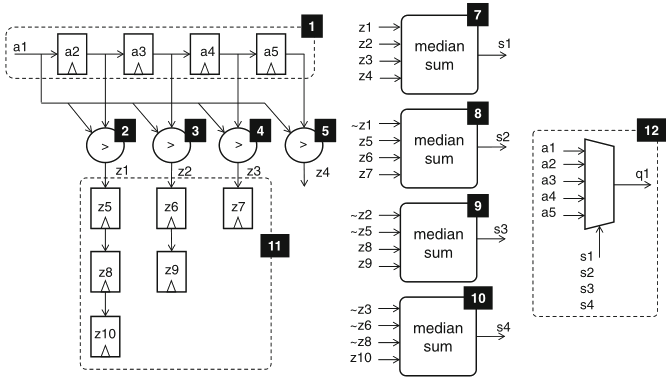
Schaumont, Figure 5.10 - Sequential schedule median-calculation datapath for a stream of values
dp t_median {
sig istr, ostr : ns(1);
sig a1_in, q1 : ns(32);
use median(istr, a1_in, ostr, q1);
reg r : ns(1);
reg c : ns(16);
always { r = ostr; }
sfg init { c = 0x1234; }
sfg sendin { a1_in = c;
c = (c[0] ˆ c[2] ˆ c[3] ˆ c[5]) # c[15:1];
istr = 1; }
sfg noin { a1_in = 0;
istr = 0; }
}
fsm ctl_t_median(t_median) {
initial s0;
state s1, s2;
@s0 (init, noin) -> s1;
@s1 (sendin) -> s2;
@s2 if (r) then (noin) -> s1;
else (noin) -> s2;
}
general hardware structure of an FSM and example of VHDL description of a Moore FSM:
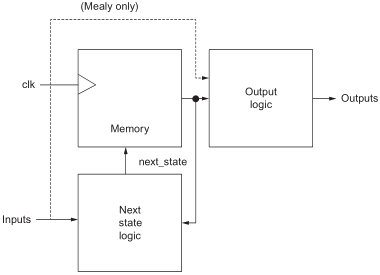
Wilson, Figure 22.1 - Hardware state machine structure
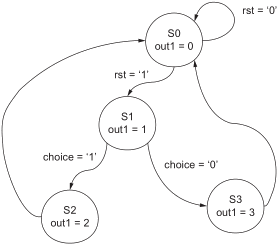
Wilson, Figure 22.2 - State transition diagram
the VHDL description of the example is taken from the textbook by Wilson, with several amendments
what about the sensitivity list of the second process? the author refers to an implicit clock... the simulation agrees with this, yet the compilation issues a warning in this respect
library ieee;
use ieee.std_logic_1164.all;
entity fsm is
port(
clk, rst, choice : in std_logic;
out1 : out std_logic_vector(1 downto 0)
);
end entity fsm;
architecture simple of fsm is
type state_type is ( s0, s1, s2, s3 );
signal current, next_state : state_type;
begin
process ( clk )
begin
if ( clk = '1' ) then
current <= next_state;
end if;
end process;
process ( current )
begin
case current is
when s0 =>
out1 <= "00";
if ( rst = '1') then
next_state <= s1;
else
next_state <= s0;
end if;
when s1=>
out1 <= "01";
if ( choice = '0') then
next_state <= s3;
else
next_state <= s2;
end if;
when s2=>
out1 <= "10";
next_state <= s0;
when s3=>
out1 <= "11";
next_state <= s0;
end case;
end process;
end;
target of this experience is the HW/SW codesign and the cosimulation, in the Gezel platform gplatform, of an FSMD model for the computation of the delay of Collatz trajectories
the functionality of the hardware datapath is similar to that of the circuit for the delay of Collatz trajectories presented in the second lecture and worked out in the second lab experience, yet with a few differences due to the communication protocol with the software and to design decisions relating to cosimulation; in particular:
recommended readings:
readings for further consultation: